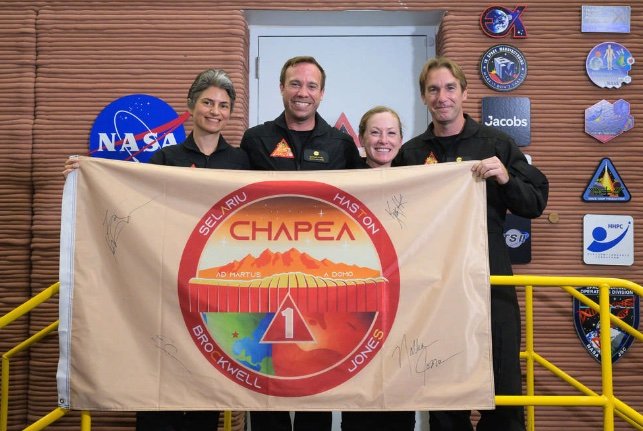Over the last decade, advancements driven by the new 21st-century space race have brought the reality of humans finally setting foot on Mars closer than ever before. The success of missions that include NASA’s Curiosity (2012) and Perseverance (2020) rovers have ignited the public imagination about the exploration of the Red Planet, and NASA has outlined how missions to Mars may also help us understand Earth’s climate, in addition to any discoveries that could await us there.
In advance of the first manned missions to Mars, NASA is already executing simulations to help prepare the astronauts who will eventually travel further from Earth than any humans have ever gone. The first of three Crew Health and Performance Exploration Analog (CHAPEA) missions began on June 25, 2023, where the four-person crew will spend 378 days in a 3D-printed habitat designed to replicate conditions on the red planet.
Composed of professionals in disciplines that range from microbiology to structural engineering, the crew and the experiments they’ll perform will allow them to leverage their professional skills in a variety of beneficial ways that will provide potentially crucial data for future Mars missions. However, even under the conditions of this simulated mission, the participants will face unique mental and physical challenges that foreshadow the stressful real-world situations future visitors to Mars will likely encounter.


CHAPEA Crew Faces Limited Contact
Arguably one of the most significant mental challenges that participants in the Mars simulation will face is that of limited contact. For 378 days, the crew will be limited to just three other people with whom they will have face-to-face contact. While this has long been a reality for astronauts—particularly those on long missions about the International Space Station (ISS)—nothing about it is an easy experience.
In the past, NASA has acknowledged that “to be as Mars-realistic as feasible, the crew also will face environmental stressors such as … isolation.” Even having three colleagues alongside them in space and the potential for video contact with others back at home, the sense of isolation can still lead to stress and anxiety. As a result, the crew will be required to cope with solitude. Past studies have found that enjoyment of solitary activities, introspection, and the understanding of when to seek and exit periods of solitude tend to be effective in mitigating isolation challenges.
Another challenge of limited connectivity is the fact that there will be four people in close quarters at all times. Even for those who may enjoy the company of others, the additional pressures of the mission may well put these constant close interactions under strain. Disagreements can arise, which might result in greater emotional and psychological tension. Therefore, strong conflict resolution practices are likely to play an essential part in navigating the simulation effectively.
Physical Wellness
Maintaining physical fitness is essential for everyone, not just astronauts. In some ways, though, it will be particularly important during the CHAPEA mission. This isn’t just because they’re going to be simulating many of the physical health pressures that would go along with long-term exposure to the harsh environment of Mars; it’s also because physical wellness is a core influencer of mental health.
From a simple physical fitness standpoint, astronauts in this simulation will face the challenge of maintaining solid exercise schedules. After all, they won’t be able to leave the habitat to engage in more enjoyable forms of outdoor exercise like hiking, cycling, and team sports. The habitat does have an exercise room with a limited amount of equipment. However, this will mean that the participants will need to adopt effective methods of motivation to keep them using the same limited exercise resources consistently in ways that positively influence their wellness.
Another physical wellness challenge that astronauts will face is access to healthcare. One of the crew members, Nathan Jones, MD, is an experienced emergency medicine physician. Certainly, a range of common health issues are well within Jones’ skill set, but there are also likely to be unique medical challenges related to a Mars mission that requires creativity and problem-solving.
Fortunately, this is something that the mission’s medical officer says he is prepared to face. In a recent interview with MedPage Today, Jones said, “I can say that’s one of the things that made me most interested in the mission—the fact that I really like finding problems and trying to fix them.”
It may be the case that for more complex or specialist medical situations, the medical officer and crew will need to collaborate virtually with external professionals. Advances in digital technology have already made telemedicine a common way to treat a range of health conditions. With access to high-definition cameras, wearable sensors, and strong internet connections, remote doctors can examine everything from dermatological issues to sleep disorders. However, collaborating with specialists in this manner during CHAPEA may be more difficult, given that external communications will experience a 22-minute delay.
Nutrition
Nutrition plays a vital role in physical and mental health. Simulating a long-term extraplanetary mission certainly creates some challenges in keeping a balanced diet. Indeed, from studies into the subject, NASA has listed a mission to Mars as a high risk of performance decrement and crew illness due to inadequate food and nutrition. The lack of access to fresh fruits and vegetables could compromise immune and cognitive functioning, among other elements.
Such factors are among the things NASA is keen to explore as part of this analog. An important part of the simulation is experiments surrounding crop growth under the conditions of a Mars habitat. Here on Earth, the agricultural industry has access to emerging innovations that can help bolster supply chains. Robotic planters can place seeds with greater precision, and drone technologies have become increasingly effective in helping monitor the condition of crops. However, utilizing agricultural technology designed for use at home is not always effective on other planets.
Such challenges have, of course, been considered in planning the mission. NASA is collaborating with advanced drone development company, Skypersonic, in providing drones and rovers that are designed for Mars. Speaking to the Associated Press, Skypersonic CEO Giuseppe Santangelo said, “The challenges are great–extremely thin atmosphere, dramatically cold temperatures, a largely unknown environment–but I am confident we will prevail and advance the science of our industry in the process.”
Details on the extent to which technology is being utilized in crop experiments have been limited. However, the tools adopted in most areas are being trialed to better understand their efficacy in various areas of missions and in supporting the ongoing wellness and productivity of crew members. Indeed, the insights gained from experimenting with tech may help influence future terraforming prospects.
Conclusion: How CHAPEA COuld Help Future Mars Missions
The first CHAPEA mission is currently underway, and its participants will face a range of mental and physical challenges. The crew’s limited contact with the outside world can see them navigating both isolation and managing crises related to long periods in close quarters with the same people. They’ll also face physical wellness challenges related to limited exercise opportunities and medical treatment access. Their nutrition, too, is likely to be dependent on the success of crop growth experiments that may be supported by advanced drones and agricultural tech.
Although the tools the crew has at their disposal are not guaranteed to be effective, part of the significance of simulations like the CHAPEA mission is to discover what kinds of unforeseen challenges they could be met with. Perhaps the most fascinating element will be how the crew is required to improvise, which may result in the innovation of new protocols.
Such discoveries could be what Mars visitors of the future will one day utilize as standards in helping them maintain both physical and mental wellness.
Amanda Winstead is a freelance writer. Follow her work online at her website.

